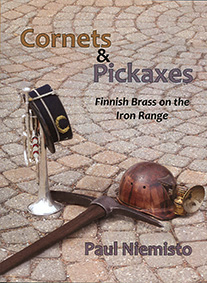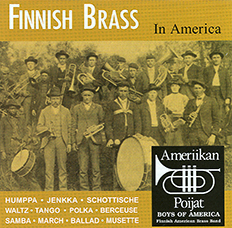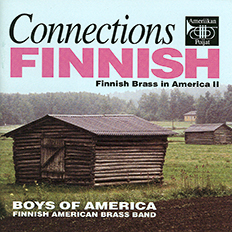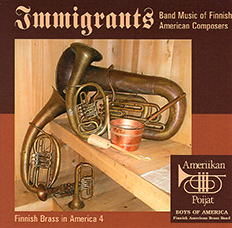A town without its brass band is as much in need of sympathy as a church without a choir. The spirit of a place is recognized in its band.
--from William H. Dana's 1898 Practical Guide, as quoted by Raoul F. Camus in a review of Cornets & Pickaxes
Paul Niemisto—musician, educator, ardent researcher, and founding director of the Finnish American Brass Septet Ameriikan Poijat—has written what will surely become a valued resource for understanding the history, cultural contributions, and legacy of the brass bands that flourished in Minnesota’s Iron Range during the twentieth century’s early decades. In clarifying the inspiration for Cornets & Pickaxes: Finnish Brass on the Iron Range, Niemisto writes of a “mission to collect and preserve information about Finnish brass bands that would otherwise be lost, to measure the value and influence that these Finnish bands had in the cultural life of the early twentieth century Iron Range, and to present the medium of the old Finnish brass band as distinct and worthy, with its own repertoire, sound, and tradition.” His book accomplishes all this and more.
Cornets & Pickaxes has been wisely organized to accommodate diverse readers. Opening chapters offer just enough historical background to illuminate the development of a brass band tradition in nineteenth century Finland, the emergence of Finnish American brass bands in the upper Midwest, their gradual development, and their eventual disappearance/assimilation. This well-paced chronological background is followed by an encyclopedic array of information. Readers most curious about specific Minnesota locales or particular musicians can quickly access pertinent sections, while those more interested in broader sociological and anthopological issues, or in musicial repertoire, can also readily access relevant material. There is commentary on how Finnish American brass bands were associated with political and social activism, with churches and temperance societies, and with the rise of music education in public schools. And, from all this, a picture forms of the overall cultural development necessary for a remote region to evolve from a frontier mainly populated by rugged, and sometimes rowdy, young and diversely ethnic male immigrants working as miners and lumbermen to a thriving community suitable for family life. The book’s plentiful and well-indexed black & white archival band photographs and other illustrations make it easier to envision the past. And its generous Afterword and Bibliography detailing Niemisto’s methodology and reassuringly extensive research processes might well entice others to take up the cause of heritage investigation and preservation. In some tucked away collection of family memorabilia, unexamined for decades and perhaps even forgotten, it’s always possible that enlightening material might yet be found. And perhaps somewhere there might still be an aging relative or neighbor with important stories to tell.
The author’s ongoing active involvement in performing the music his book explores brings a bandsman's eye to his handling of the history. In commenting on an archival photograph of a Finnish Workers Band, Niemisto not only provides the expected who, where, and when of the scene, but calls attention to the attitude suggested by the tilt of the musicians’ hats, their smoldering cigars and boutonnieres of wildflowers. His analysis of the style and complexity of archival recordings and music books reflects convincing brass band expertise. His inclusion of old-time instructions to brass pupils and novice teachers charmingly reveals certain timeless elements of music teaching and learning. But perhaps this book's most profound element of all is that underscored in its Foreword by Lee Egerstrom. Ater noting that Cornets & Pickaxes offers a “glimpse at how music makers bring harmony to our communities,” Egerstrom adds that this role of musicians “remains under-appreciated in our land of immigrants and refugees.” Yet he ends with the hope that the accomplishments of the Finnish American musicians in Niemisto’s book will “shine a light for newer Americans to follow.” By helping twenty-first century readers more thoroughly appreciate how immigrant musicians in earlier times played a role in “keeping the peace, bonding community, and moving society forward,” this book’s preservation of the past can indeed become resounding inspiration for the future.
How to Order
More From Paul Niemisto

Ameriikan Poijat (Boys of America), and Two Girls, performing in Nurmes, Finland 2012 |
The spirited and adventuresome Ameriikan Poijat Brass Septet has been performing and exploring the traditions of Finnish and Finnish American brass bands ever since its founding in 1990 by Director Paul Niemisto. This sustained attention now enables the band to claim the distinction of being the only brass band in the world that has played “in an ice arena, in fishing boats, on the Perhojoki river, on a raft in an abandoned mine, at Finnish border defense installations, at the McDonnell-Douglas aircraft plant, in a Wisconsin cow pasture, on a Florida beach, at an instrument museum, in a barn, and in a one room school house.”
Whether adapting to unconventional spaces or playing in concert halls and dance halls, Ameriikan Poijat has much to offer fans of the distinctively Finnish brass band tradition, newcomers to this cultural heritage, scholars in the field, and general admirers of the sounds of a hearty brass band. Their music is readily available to sample or purchase via the four album links featured below. In addition, a sampling of sheet music drawn from their research into the heritage of Finnish brass septets is available for purchase in pdf format via this link >>>>>.
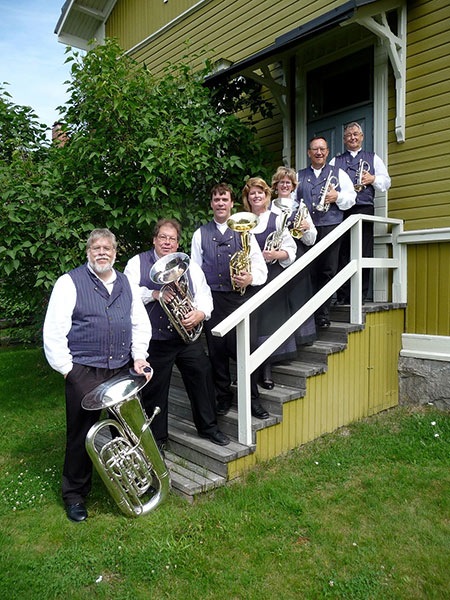
Ameriikan Poijat (Boys of America), and Two Girls,
at the Old Kuopio Museum during a summer 2012 tour of Finland |
|
